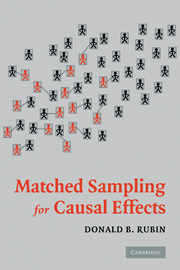Book contents
- Frontmatter
- Contents
- Contributor Acknowledgments
- Matched Sampling for Causal Effects
- My Introduction to Matched Sampling
- PART I THE EARLY YEARS AND THE INFLUENCE OF WILLIAM G. COCHRAN
- PART II UNIVARIATE MATCHING METHODS AND THE DANGERS OF REGRESSION ADJUSTMENT
- PART III BASIC THEORY OF MULTIVARIATE MATCHING
- 6 Multivariate Matching Methods That Are Equal Percent Bias Reducing, I: Some Examples
- 7 Multivariate Matching Methods That Are Equal Percent Bias Reducing, II: Maximums on Bias Reduction for Fixed Sample Sizes
- 8 Using Multivariate Matched Sampling and Regression Adjustment to Control Bias in Observational Studies
- 9 Bias Reduction Using Mahalanobis-Metric Matching
- PART IV FUNDAMENTALS OF PROPENSITY SCORE MATCHING
- PART V AFFINELY INVARIANT MATCHING METHODS WITH ELLIPSOIDALLY SYMMETRIC DISTRIBUTIONS, THEORY AND METHODOLOGY
- PART VI SOME APPLIED CONTRIBUTIONS
- PART VII SOME FOCUSED APPLICATIONS
- Conclusion: Advice to the Investigator
- References
- Author Index
- Subject Index
9 - Bias Reduction Using Mahalanobis-Metric Matching
Published online by Cambridge University Press: 05 June 2012
- Frontmatter
- Contents
- Contributor Acknowledgments
- Matched Sampling for Causal Effects
- My Introduction to Matched Sampling
- PART I THE EARLY YEARS AND THE INFLUENCE OF WILLIAM G. COCHRAN
- PART II UNIVARIATE MATCHING METHODS AND THE DANGERS OF REGRESSION ADJUSTMENT
- PART III BASIC THEORY OF MULTIVARIATE MATCHING
- 6 Multivariate Matching Methods That Are Equal Percent Bias Reducing, I: Some Examples
- 7 Multivariate Matching Methods That Are Equal Percent Bias Reducing, II: Maximums on Bias Reduction for Fixed Sample Sizes
- 8 Using Multivariate Matched Sampling and Regression Adjustment to Control Bias in Observational Studies
- 9 Bias Reduction Using Mahalanobis-Metric Matching
- PART IV FUNDAMENTALS OF PROPENSITY SCORE MATCHING
- PART V AFFINELY INVARIANT MATCHING METHODS WITH ELLIPSOIDALLY SYMMETRIC DISTRIBUTIONS, THEORY AND METHODOLOGY
- PART VI SOME APPLIED CONTRIBUTIONS
- PART VII SOME FOCUSED APPLICATIONS
- Conclusion: Advice to the Investigator
- References
- Author Index
- Subject Index
Summary
Abstract: Monte Carlo methods are used to study the ability of nearest-available, Mahalanobis-metric matching to make the means of matching variables more similar in matched samples than in random samples.
INTRODUCTION
Matched sampling is a method for selecting treatment units (e.g., smokers) and control units (e.g., nonsmokers) with similar values of matching variables X (e.g., age, sex, family medical history). Rubin (1976b,c) presented analytical work on a class of matching methods for multivariate X, which are called ‘equal percent bias reducing’ (EPBR) because they yield the same percent reduction in expected bias for each matching variable, and thus for each linear combination of the matching variables. If the matching method is not EPBR, then there are different percent reductions in bias for different matching variables; in fact, any non-EPBR matching method increases bias for some linear combinations of the matching variables.
This communication extends the previous work of Rubin (1976b, c) by presenting Monte Carlo values for the percent reduction in bias when X is bivariate normal, and nearest-available, Mahalanobis-metric, pair matching is used. Related theoretical work on this matching method appears in Carpenter (1977). We chose to study Mahalanobis-metric matching because it is: (i) EPBR under commonly assumed distributional conditions (see Rubin, 1976b, §2); (ii) a natural extension of univariate nearest-available-pair matching methods studied earlier (Rubin, 1973a, b; Cochran and Rubin, 1973), in the sense that it attempts to find pair matches close on all matching variables; (iii) easy to implement in practice by using commonly available computer programs for sorting and calculating sample covariance matrices; and (iv) superior to another EPBR pair-matching method for nonlinear response surfaces (Rubin, 1979b).
- Type
- Chapter
- Information
- Matched Sampling for Causal Effects , pp. 160 - 166Publisher: Cambridge University PressPrint publication year: 2006
- 1
- Cited by

